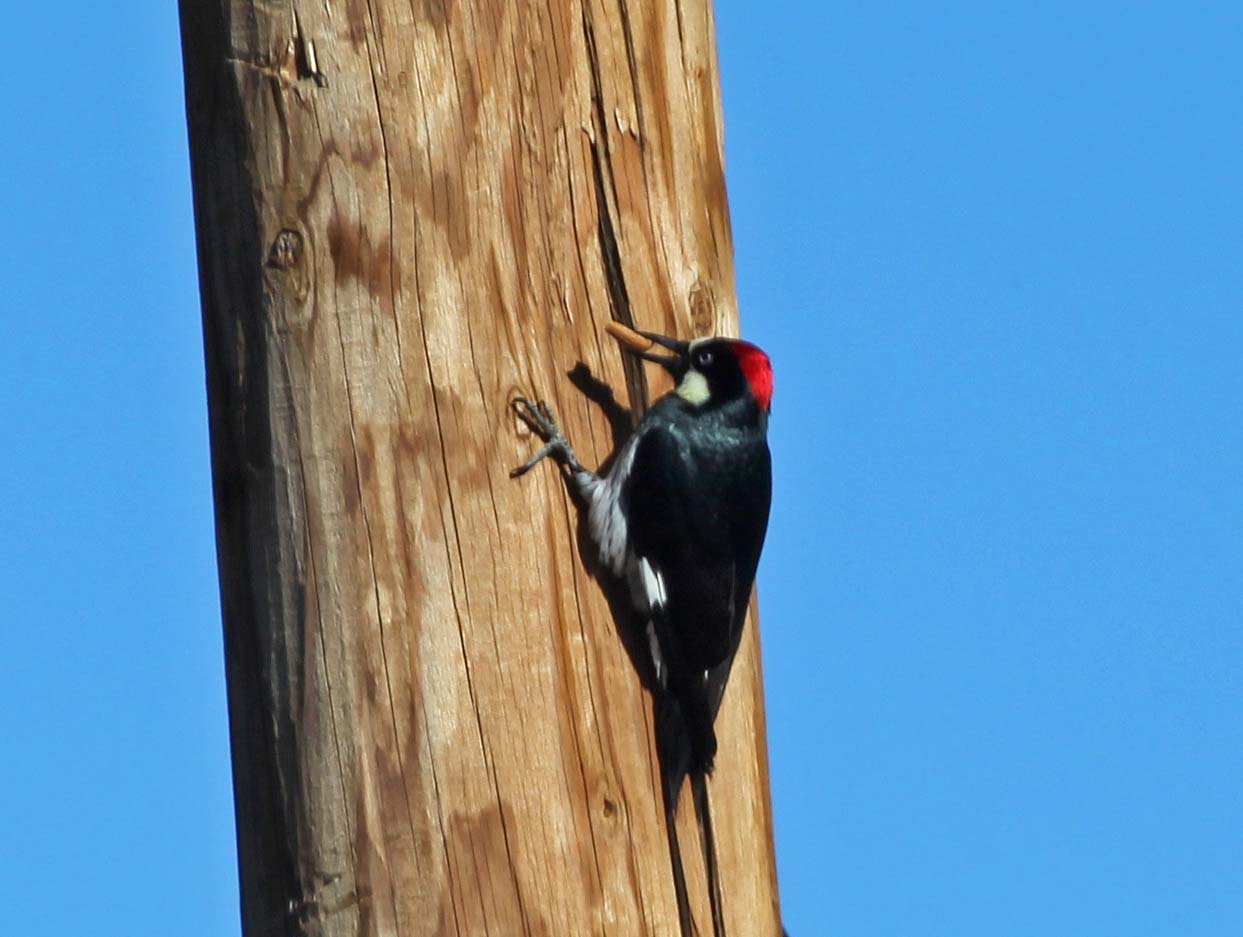

This live bird was identified in 2009 by its colored leg band, which it had been wearing since 1992. The oldest Acorn Woodpecker on record was at least 17 years, 3 months old.Once all the females start to lay, they stop removing eggs. A female usually destroys any eggs in the nest before she starts to lay, and more than one third of all eggs laid in joint nests are destroyed. In groups with more than one breeding female, the females put their eggs into a single nest cavity.They prefer oak woodlands with a more open understory and rely on mature oaks for both. In California and Oregon, and slightly into Washington, they are associated with oaks in the genus Quercus, often the Oregon white oak or the black oak. If the stores are eaten, the woodpecker will move to another area, even going from Arizona to Mexico to spend the winter. The Acorn Woodpecker is an oak woodland specialist, relying on oaks for food, shelter and nest cavities.

In parts of its range the Acorn Woodpecker does not construct a granary tree, but instead stores acorns in natural holes and cracks in bark. Woodpeckers put 220 kg (485 lb) of acorns into a wooden water tank in Arizona. Occasionally the woodpecker will put acorns into places where it cannot get them out. The Acorn Woodpecker will use human-made structures to store acorns, drilling holes in fenceposts, utility poles, buildings, and even automobile radiators.One granary tree may have up to 50,000 holes in it, each of which is filled with an acorn in autumn. Acorns typically are stored in holes drilled into a single tree, called a granary tree. All members of an Acorn Woodpecker group spend large amounts of time storing acorns.Several different individuals of each sex may breed within one family, with up to seven breeding males and three breeding females in one group. Family groups hold territories, and young woodpeckers stay with their parents for several years and help the parents raise more young. The Acorn Woodpecker has a very complicated social system.In 1923, American ornithologist William Leon Dawson called the dapper Acorn Woodpecker “our native aristocrat.” Dawson wrote: “He is unruffled by the operations of the human plebs in whatever disguise…Wigwams, haciendas, or university halls, what matter such frivolities, if only one may go calmly on with the main business of life, which is indubitably the hoarding of acorns.”.He was banded in New Jersey and found six years later in South Carolina. The oldest known Yellow-bellied Sapsucker was a male, and at least 7 years, 9 months old. Similar looking birds to Lewis's Woodpecker: Acorn Woodpecker Male, Black-backed Woodpecker Female Similar Species to Lewis's Woodpecker, All About Birds, Cornell Lab of Ornithology Photos comparing this bird species with similar or confusing species, including captions that point out specific differences to help confirm identification.Females tend to migrate farther south than do males. Although a few individuals remain throughout much of the winter in the southern part of the breeding range, most head farther south, going as far south as Panama. The Yellow-bellied Sapsucker is the only woodpecker in eastern North America that is completely migratory.The sapsucker seems to suffer no ill effects of whacking its bill on metal, and a bird will return to a favorite sign day after day to pound out its Morse code-like message. Street signs and metal chimney flashing amplify the irregular tapping of a territorial sapsucker. The Yellow-bellied Sapsucker frequently uses human-produced materials to help in its territorial drumming.Yellow-bellied Sapsuckers have been found drilling sapwells in more than 1,000 species of trees and woody plants, though they have a strong preference for birches and maples.Other birds as well as bats and porcupines also visit sapsucker sapwells. In some parts of Canada, Ruby-throated Hummingbirds rely so much on sapwells that they time their spring migration with the arrival of sapsuckers. The sapwells made by Yellow-bellied Sapsuckers attract hummingbirds, which also feed off the sap flowing from the tree.New holes usually are made in a line with old holes, or in a new line above the old.

The sapsucker licks the sap from these holes, and eats the cambium of the tree too. Rectangular holes are shallower, and must be maintained continually for the sap to flow. The sapsucker inserts its bill into the hole to probe for sap. Round holes extend deep in the tree and are not enlarged.


 0 kommentar(er)
0 kommentar(er)
